coolant temperature JEEP GLADIATOR 2023 User Guide
[x] Cancel search | Manufacturer: JEEP, Model Year: 2023, Model line: GLADIATOR, Model: JEEP GLADIATOR 2023Pages: 448, PDF Size: 17.37 MB
Page 280 of 448
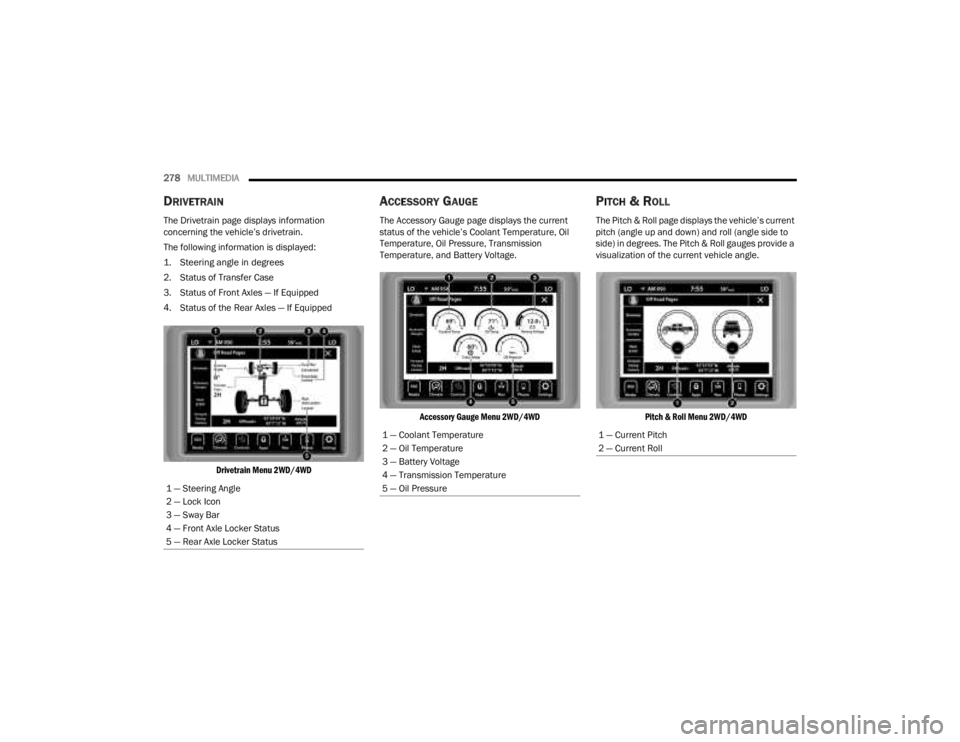
278MULTIMEDIA
DRIVETRAIN
The Drivetrain page displays information
concerning the vehicle’s drivetrain.
The following information is displayed:
1. Steering angle in degrees
2. Status of Transfer Case
3. Status of Front Axles — If Equipped
4. Status of the Rear Axles — If Equipped
Drivetrain Menu 2WD/4WD
ACCESSORY GAUGE
The Accessory Gauge page displays the current
status of the vehicle’s Coolant Temperature, Oil
Temperature, Oil Pressure, Transmission
Temperature, and Battery Voltage.
Accessory Gauge Menu 2WD/4WD
PITCH & ROLL
The Pitch & Roll page displays the vehicle’s current
pitch (angle up and down) and roll (angle side to
side) in degrees. The Pitch & Roll gauges provide a
visualization of the current vehicle angle.
Pitch & Roll Menu 2WD/4WD
1 — Steering Angle
2 — Lock Icon
3 — Sway Bar
4 — Front Axle Locker Status
5 — Rear Axle Locker Status
1 — Coolant Temperature
2 — Oil Temperature
3 — Battery Voltage
4 — Transmission Temperature
5 — Oil Pressure1 — Current Pitch
2 — Current Roll
23_JT_OM_EN_USC_t.book Page 278
Page 349 of 448
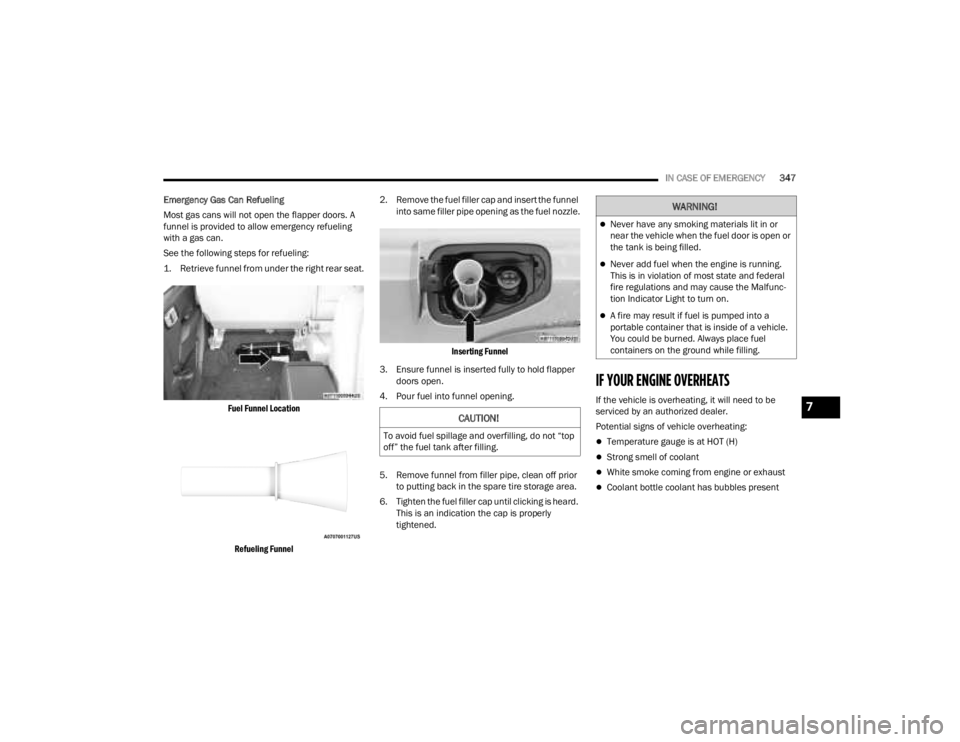
IN CASE OF EMERGENCY347
Emergency Gas Can Refueling
Most gas cans will not open the flapper doors. A
funnel is provided to allow emergency refueling
with a gas can.
See the following steps for refueling:
1. Retrieve funnel from under the right rear seat.
Fuel Funnel Location
Refueling Funnel
2. Remove the fuel filler cap and insert the funnel
into same filler pipe opening as the fuel nozzle.
Inserting Funnel
3. Ensure funnel is inserted fully to hold flapper doors open.
4. Pour fuel into funnel opening.
5. Remove funnel from filler pipe, clean off prior to putting back in the spare tire storage area.
6. Tighten the fuel filler cap until clicking is heard. This is an indication the cap is properly
tightened.
IF YOUR ENGINE OVERHEATS
If the vehicle is overheating, it will need to be
serviced by an authorized dealer.
Potential signs of vehicle overheating:
Temperature gauge is at HOT (H)
Strong smell of coolant
White smoke coming from engine or exhaust
Coolant bottle coolant has bubbles present
CAUTION!
To avoid fuel spillage and overfilling, do not “top
off” the fuel tank after filling.
WARNING!
Never have any smoking materials lit in or
near the vehicle when the fuel door is open or
the tank is being filled.
Never add fuel when the engine is running.
This is in violation of most state and federal
fire regulations and may cause the Malfunc -
tion Indicator Light to turn on.
A fire may result if fuel is pumped into a
portable container that is inside of a vehicle.
You could be burned. Always place fuel
containers on the ground while filling.
7
23_JT_OM_EN_USC_t.book Page 347
Page 350 of 448
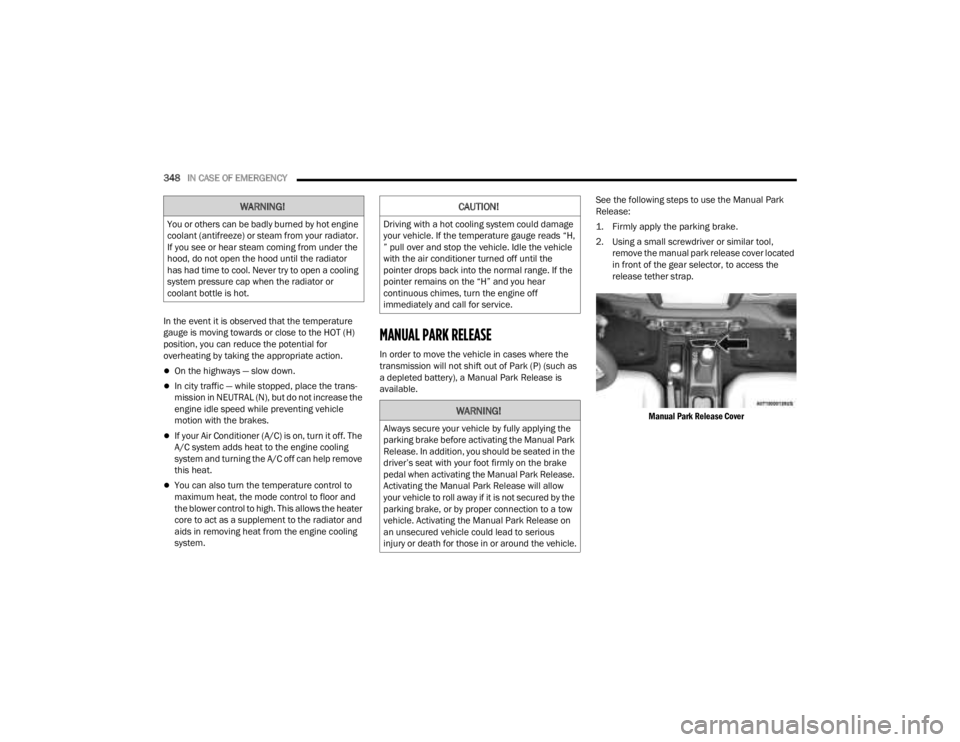
348IN CASE OF EMERGENCY
In the event it is observed that the temperature
gauge is moving towards or close to the HOT (H)
position, you can reduce the potential for
overheating by taking the appropriate action.
On the highways — slow down.
In city traffic — while stopped, place the trans -
mission in NEUTRAL (N), but do not increase the
engine idle speed while preventing vehicle
motion with the brakes.
If your Air Conditioner (A/C) is on, turn it off. The
A/C system adds heat to the engine cooling
system and turning the A/C off can help remove
this heat.
You can also turn the temperature control to
maximum heat, the mode control to floor and
the blower control to high. This allows the heater
core to act as a supplement to the radiator and
aids in removing heat from the engine cooling
system.
MANUAL PARK RELEASE
In order to move the vehicle in cases where the
transmission will not shift out of Park (P) (such as
a depleted battery), a Manual Park Release is
available. See the following steps to use the Manual Park
Release:
1. Firmly apply the parking brake.
2. Using a small screwdriver or similar tool,
remove the manual park release cover located
in front of the gear selector, to access the
release tether strap.
Manual Park Release Cover
WARNING!
You or others can be badly burned by hot engine
coolant (antifreeze) or steam from your radiator.
If you see or hear steam coming from under the
hood, do not open the hood until the radiator
has had time to cool. Never try to open a cooling
system pressure cap when the radiator or
coolant bottle is hot.
CAUTION!
Driving with a hot cooling system could damage
your vehicle. If the temperature gauge reads “H,
” pull over and stop the vehicle. Idle the vehicle
with the air conditioner turned off until the
pointer drops back into the normal range. If the
pointer remains on the “H” and you hear
continuous chimes, turn the engine off
immediately and call for service.
WARNING!
Always secure your vehicle by fully applying the
parking brake before activating the Manual Park
Release. In addition, you should be seated in the
driver’s seat with your foot firmly on the brake
pedal when activating the Manual Park Release.
Activating the Manual Park Release will allow
your vehicle to roll away if it is not secured by the
parking brake, or by proper connection to a tow
vehicle. Activating the Manual Park Release on
an unsecured vehicle could lead to serious
injury or death for those in or around the vehicle.
23_JT_OM_EN_USC_t.book Page 348
Page 355 of 448
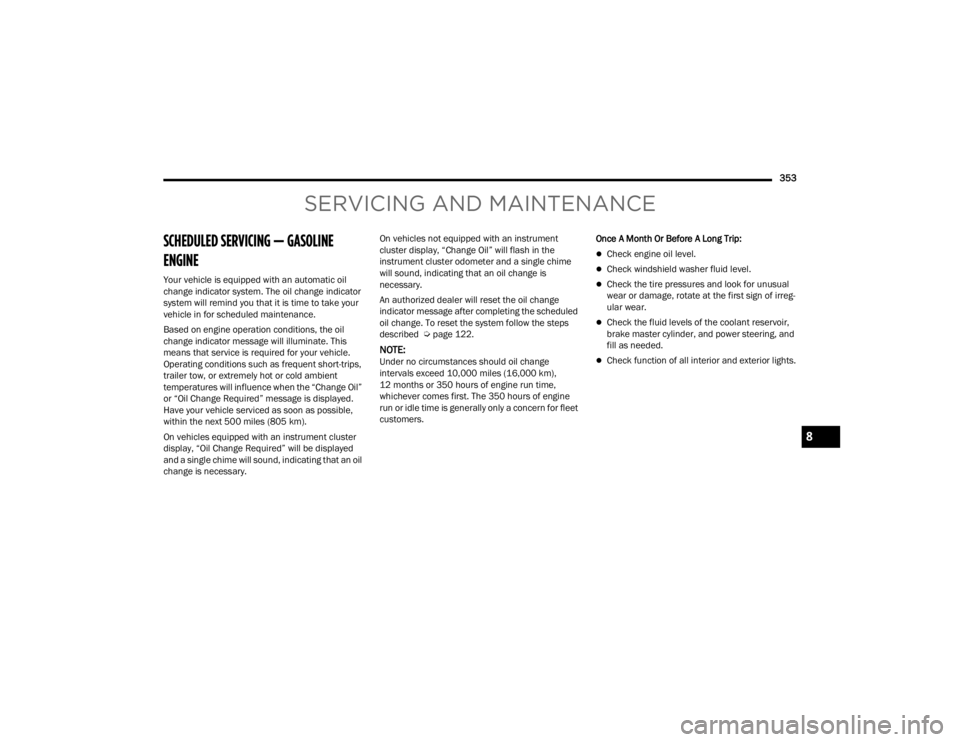
353
SERVICING AND MAINTENANCE
SCHEDULED SERVICING — GASOLINE
ENGINE
Your vehicle is equipped with an automatic oil
change indicator system. The oil change indicator
system will remind you that it is time to take your
vehicle in for scheduled maintenance.
Based on engine operation conditions, the oil
change indicator message will illuminate. This
means that service is required for your vehicle.
Operating conditions such as frequent short-trips,
trailer tow, or extremely hot or cold ambient
temperatures will influence when the “Change Oil”
or “Oil Change Required” message is displayed.
Have your vehicle serviced as soon as possible,
within the next 500 miles (805 km).
On vehicles equipped with an instrument cluster
display, “Oil Change Required” will be displayed
and a single chime will sound, indicating that an oil
change is necessary. On vehicles not equipped with an instrument
cluster display, “Change Oil” will flash in the
instrument cluster odometer and a single chime
will sound, indicating that an oil change is
necessary.
An authorized dealer will reset the oil change
indicator message after completing the scheduled
oil change. To reset the system follow the steps
described Ú
page 122.
NOTE:Under no circumstances should oil change
intervals exceed 10,000 miles (16,000 km),
12 months or 350 hours of engine run time,
whichever comes first. The 350 hours of engine
run or idle time is generally only a concern for fleet
customers. Once A Month Or Before A Long Trip:
Check engine oil level.
Check windshield washer fluid level.
Check the tire pressures and look for unusual
wear or damage, rotate at the first sign of irreg
-
ular wear.
Check the fluid levels of the coolant reservoir,
brake master cylinder, and power steering, and
fill as needed.
Check function of all interior and exterior lights.
8
23_JT_OM_EN_USC_t.book Page 353
Page 359 of 448
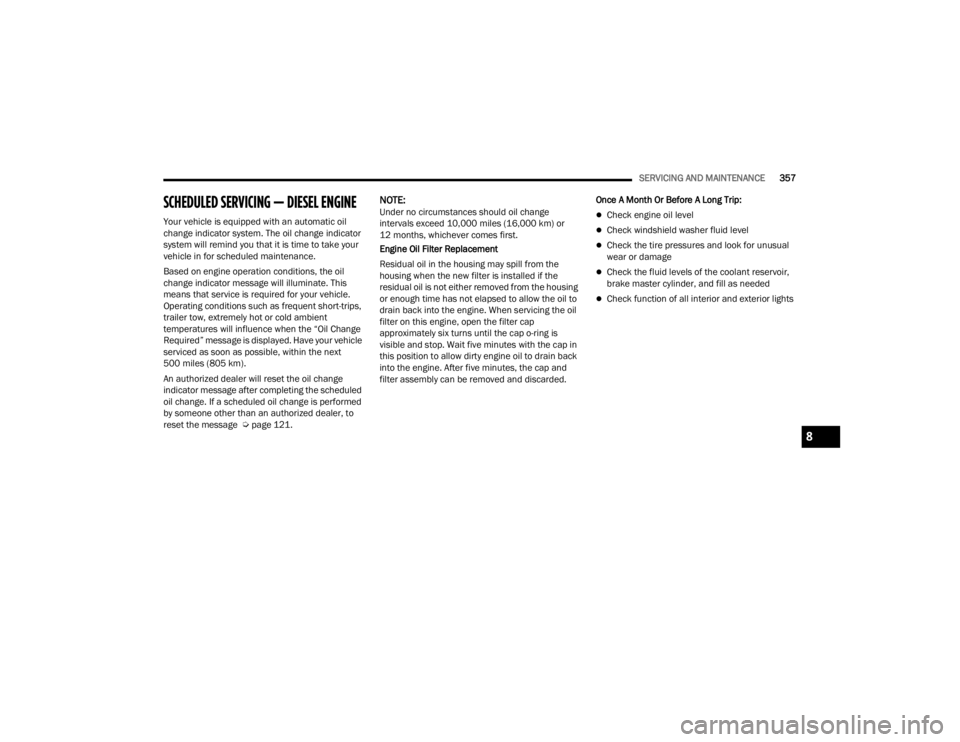
SERVICING AND MAINTENANCE357
SCHEDULED SERVICING — DIESEL ENGINE
Your vehicle is equipped with an automatic oil
change indicator system. The oil change indicator
system will remind you that it is time to take your
vehicle in for scheduled maintenance.
Based on engine operation conditions, the oil
change indicator message will illuminate. This
means that service is required for your vehicle.
Operating conditions such as frequent short-trips,
trailer tow, extremely hot or cold ambient
temperatures will influence when the “Oil Change
Required” message is displayed. Have your vehicle
serviced as soon as possible, within the next
500 miles (805 km).
An authorized dealer will reset the oil change
indicator message after completing the scheduled
oil change. If a scheduled oil change is performed
by someone other than an authorized dealer, to
reset the message Úpage 121.
NOTE:Under no circumstances should oil change
intervals exceed 10,000 miles (16,000 km) or
12 months, whichever comes first.
Engine Oil Filter Replacement
Residual oil in the housing may spill from the
housing when the new filter is installed if the
residual oil is not either removed from the housing
or enough time has not elapsed to allow the oil to
drain back into the engine. When servicing the oil
filter on this engine, open the filter cap
approximately six turns until the cap o-ring is
visible and stop. Wait five minutes with the cap in
this position to allow dirty engine oil to drain back
into the engine. After five minutes, the cap and
filter assembly can be removed and discarded. Once A Month Or Before A Long Trip:Check engine oil level
Check windshield washer fluid level
Check the tire pressures and look for unusual
wear or damage
Check the fluid levels of the coolant reservoir,
brake master cylinder, and fill as needed
Check function of all interior and exterior lights
8
23_JT_OM_EN_USC_t.book Page 357
Page 380 of 448
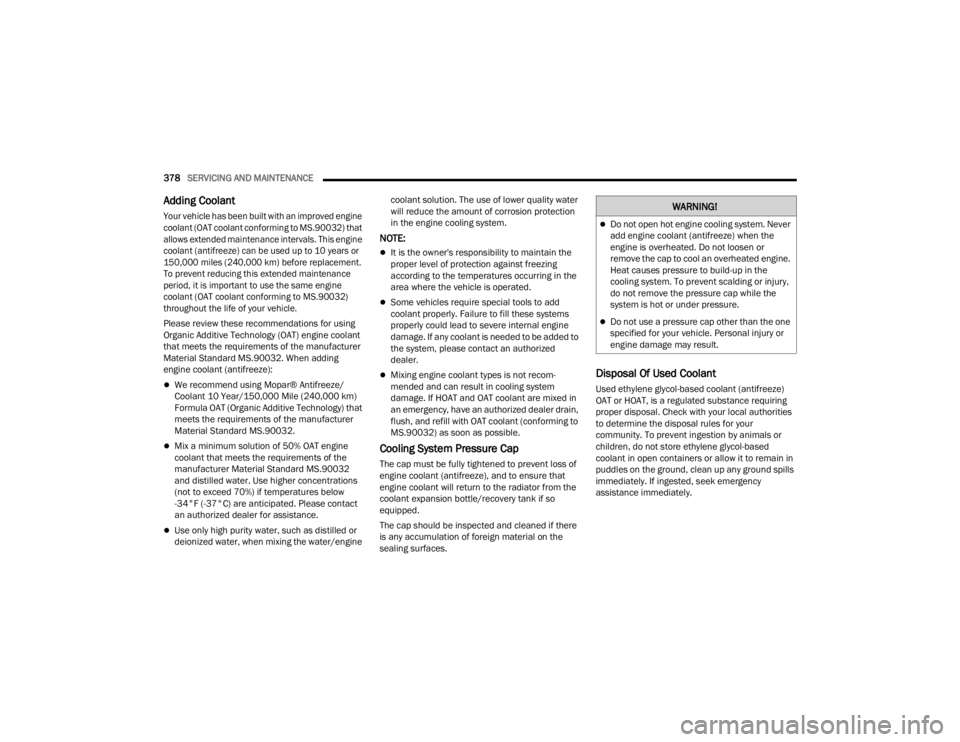
378SERVICING AND MAINTENANCE
Adding Coolant
Your vehicle has been built with an improved engine
coolant (OAT coolant conforming to MS.90032) that
allows extended maintenance intervals. This engine
coolant (antifreeze) can be used up to 10 years or
150,000 miles (240,000 km) before replacement.
To prevent reducing this extended maintenance
period, it is important to use the same engine
coolant (OAT coolant conforming to MS.90032)
throughout the life of your vehicle.
Please review these recommendations for using
Organic Additive Technology (OAT) engine coolant
that meets the requirements of the manufacturer
Material Standard MS.90032. When adding
engine coolant (antifreeze):
We recommend using Mopar® Antifreeze/
Coolant 10 Year/150,000 Mile (240,000 km)
Formula OAT (Organic Additive Technology) that
meets the requirements of the manufacturer
Material Standard MS.90032.
Mix a minimum solution of 50% OAT engine
coolant that meets the requirements of the
manufacturer Material Standard MS.90032
and distilled water. Use higher concentrations
(not to exceed 70%) if temperatures below
-34°F (-37°C) are anticipated. Please contact
an authorized dealer for assistance.
Use only high purity water, such as distilled or
deionized water, when mixing the water/engine coolant solution. The use of lower quality water
will reduce the amount of corrosion protection
in the engine cooling system.
NOTE:
It is the owner's responsibility to maintain the
proper level of protection against freezing
according to the temperatures occurring in the
area where the vehicle is operated.
Some vehicles require special tools to add
coolant properly. Failure to fill these systems
properly could lead to severe internal engine
damage. If any coolant is needed to be added to
the system, please contact an authorized
dealer.
Mixing engine coolant types is not recom
-
mended and can result in cooling system
damage. If HOAT and OAT coolant are mixed in
an emergency, have an authorized dealer drain,
flush, and refill with OAT coolant (conforming to
MS.90032) as soon as possible.
Cooling System Pressure Cap
The cap must be fully tightened to prevent loss of
engine coolant (antifreeze), and to ensure that
engine coolant will return to the radiator from the
coolant expansion bottle/recovery tank if so
equipped.
The cap should be inspected and cleaned if there
is any accumulation of foreign material on the
sealing surfaces.
Disposal Of Used Coolant
Used ethylene glycol-based coolant (antifreeze)
OAT or HOAT, is a regulated substance requiring
proper disposal. Check with your local authorities
to determine the disposal rules for your
community. To prevent ingestion by animals or
children, do not store ethylene glycol-based
coolant in open containers or allow it to remain in
puddles on the ground, clean up any ground spills
immediately. If ingested, seek emergency
assistance immediately.
WARNING!
Do not open hot engine cooling system. Never
add engine coolant (antifreeze) when the
engine is overheated. Do not loosen or
remove the cap to cool an overheated engine.
Heat causes pressure to build-up in the
cooling system. To prevent scalding or injury,
do not remove the pressure cap while the
system is hot or under pressure.
Do not use a pressure cap other than the one
specified for your vehicle. Personal injury or
engine damage may result.
23_JT_OM_EN_USC_t.book Page 378
Page 381 of 448
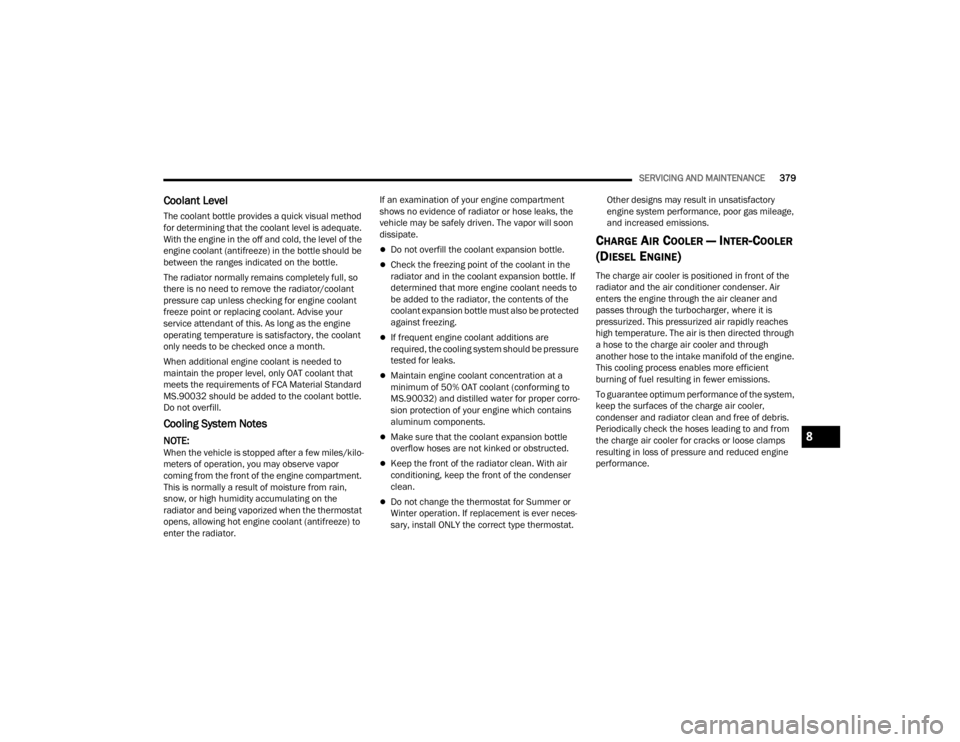
SERVICING AND MAINTENANCE379
Coolant Level
The coolant bottle provides a quick visual method
for determining that the coolant level is adequate.
With the engine in the off and cold, the level of the
engine coolant (antifreeze) in the bottle should be
between the ranges indicated on the bottle.
The radiator normally remains completely full, so
there is no need to remove the radiator/coolant
pressure cap unless checking for engine coolant
freeze point or replacing coolant. Advise your
service attendant of this. As long as the engine
operating temperature is satisfactory, the coolant
only needs to be checked once a month.
When additional engine coolant is needed to
maintain the proper level, only OAT coolant that
meets the requirements of FCA Material Standard
MS.90032 should be added to the coolant bottle.
Do not overfill.
Cooling System Notes
NOTE:When the vehicle is stopped after a few miles/kilo -
meters of operation, you may observe vapor
coming from the front of the engine compartment.
This is normally a result of moisture from rain,
snow, or high humidity accumulating on the
radiator and being vaporized when the thermostat
opens, allowing hot engine coolant (antifreeze) to
enter the radiator. If an examination of your engine compartment
shows no evidence of radiator or hose leaks, the
vehicle may be safely driven. The vapor will soon
dissipate.
Do not overfill the coolant expansion bottle.
Check the freezing point of the coolant in the
radiator and in the coolant expansion bottle. If
determined that more engine coolant needs to
be added to the radiator, the contents of the
coolant expansion bottle must also be protected
against freezing.
If frequent engine coolant additions are
required, the cooling system should be pressure
tested for leaks.
Maintain engine coolant concentration at a
minimum of 50% OAT coolant (conforming to
MS.90032) and distilled water for proper corro
-
sion protection of your engine which contains
aluminum components.
Make sure that the coolant expansion bottle
overflow hoses are not kinked or obstructed.
Keep the front of the radiator clean. With air
conditioning, keep the front of the condenser
clean.
Do not change the thermostat for Summer or
Winter operation. If replacement is ever neces -
sary, install ONLY the correct type thermostat. Other designs may result in unsatisfactory
engine system performance, poor gas mileage,
and increased emissions.
CHARGE AIR COOLER — INTER-COOLER
(D
IESEL ENGINE)
The charge air cooler is positioned in front of the
radiator and the air conditioner condenser. Air
enters the engine through the air cleaner and
passes through the turbocharger, where it is
pressurized. This pressurized air rapidly reaches
high temperature. The air is then directed through
a hose to the charge air cooler and through
another hose to the intake manifold of the engine.
This cooling process enables more efficient
burning of fuel resulting in fewer emissions.
To guarantee optimum performance of the system,
keep the surfaces of the charge air cooler,
condenser and radiator clean and free of debris.
Periodically check the hoses leading to and from
the charge air cooler for cracks or loose clamps
resulting in loss of pressure and reduced engine
performance.
8
23_JT_OM_EN_USC_t.book Page 379
Page 435 of 448
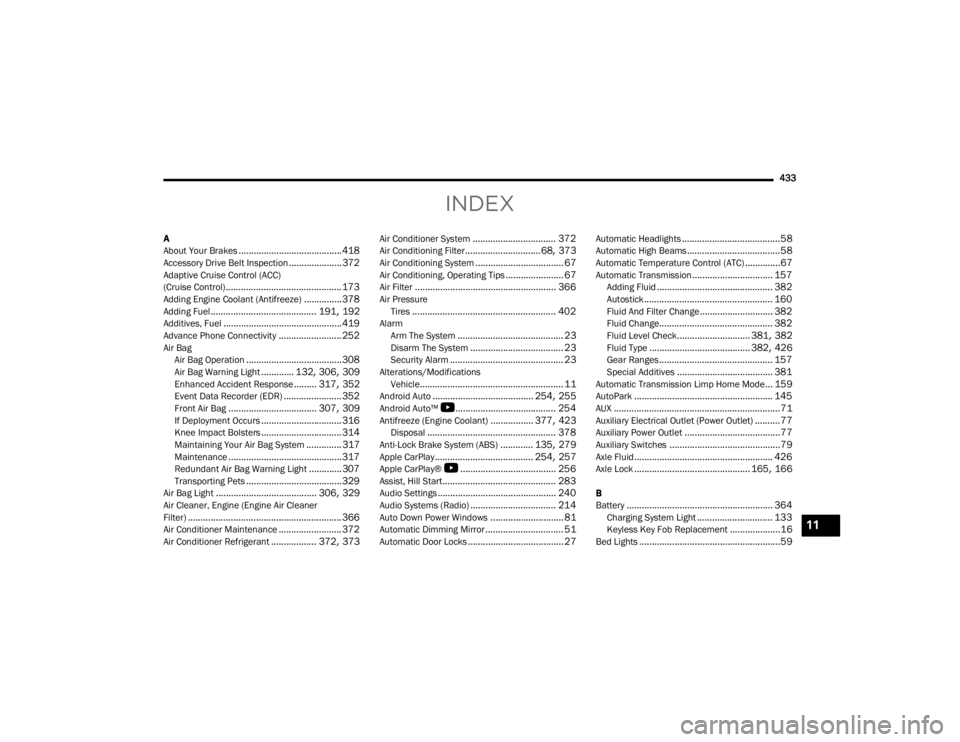
433
INDEX
A
About Your Brakes......................................... 418Accessory Drive Belt Inspection..................... 372Adaptive Cruise Control (ACC)
(Cruise Control).............................................. 173Adding Engine Coolant (Antifreeze)............... 378Adding Fuel.......................................... 191, 192Additives, Fuel............................................... 419Advance Phone Connectivity......................... 252Air BagAir Bag Operation...................................... 308Air Bag Warning Light............. 132, 306, 309Enhanced Accident Response......... 317, 352Event Data Recorder (EDR)....................... 352Front Air Bag................................... 307, 309If Deployment Occurs................................ 316Knee Impact Bolsters................................ 314Maintaining Your Air Bag System.............. 317Maintenance............................................. 317Redundant Air Bag Warning Light.............307Transporting Pets...................................... 329Air Bag Light........................................ 306, 329Air Cleaner, Engine (Engine Air Cleaner
Filter)............................................................. 366Air Conditioner Maintenance......................... 372Air Conditioner Refrigerant.................. 372, 373
Air Conditioner System................................. 372Air Conditioning Filter..............................68, 373Air Conditioning System................................... 67Air Conditioning, Operating Tips....................... 67Air Filter........................................................ 366Air PressureTires......................................................... 402AlarmArm The System.......................................... 23Disarm The System..................................... 23Security Alarm............................................. 23Alterations/ModificationsVehicle......................................................... 11Android Auto........................................ 254, 255Android Auto™
S
........................................ 254Antifreeze (Engine Coolant)................. 377, 423Disposal................................................... 378Anti-Lock Brake System (ABS)............. 135, 279Apple CarPlay....................................... 254, 257Apple CarPlay®
S
...................................... 256Assist, Hill Start............................................. 283Audio Settings............................................... 240Audio Systems (Radio).................................. 214Auto Down Power Windows............................. 81Automatic Dimming Mirror............................... 51Automatic Door Locks...................................... 27
Automatic Headlights.......................................58Automatic High Beams.....................................58Automatic Temperature Control (ATC)..............67Automatic Transmission................................ 157Adding Fluid.............................................. 382Autostick................................................... 160Fluid And Filter Change............................. 382Fluid Change............................................. 382Fluid Level Check............................. 381, 382Fluid Type........................................ 382, 426Gear Ranges............................................. 157Special Additives...................................... 381Automatic Transmission Limp Home Mode... 159AutoPark....................................................... 145AUX..................................................................71Auxiliary Electrical Outlet (Power Outlet)..........77Auxiliary Power Outlet......................................77Auxiliary Switches............................................79Axle Fluid....................................................... 426Axle Lock.............................................. 165, 166
B
Battery.......................................................... 364Charging System Light.............................. 133Keyless Key Fob Replacement....................16Bed Lights........................................................59
11
23_JT_OM_EN_USC_t.book Page 433
Page 440 of 448

438
Leaks, Fluid
................................................... 330Leather Surfaces........................................... 417Life Of Tires................................................... 404Light Bulbs........................................... 330, 392Lights............................................................. 3304WD.......................................................... 1384WD Auto.................................................. 1394WD Low................................................... 1384WD Part Time.......................................... 138AdBlue UREA Injection System Failure...... 138Air Bag.................................... 132, 306, 329Automatic Headlights.................................. 58Axle Locker Fault....................................... 138Bed.............................................................. 59Brake Assist Warning................................ 283Brake Warning.......................................... 132Bulb Replacement..................................... 393Cargo......................................................... 139Center Mounted Stop................................ 395Daytime Running......................................... 57Dimmer Switch, Headlight........................... 57Electronic Throttle Control......................... 133Engine Check Malfunction Indicator..........136Engine Coolant Temperature..................... 133Exterior............................................... 56, 330Fog............................................58, 140, 394Front And Rear Axle Lock.......................... 138Hazard Warning Flasher............................ 332Headlight Switch......................................... 56Headlights.......................................... 56, 393
High Beam..........................................57, 141High Beam/Low Beam Select...................... 57Hood Open............................................... 133Instrument Cluster....................................... 56Interior......................................................... 59Lights On Reminder..................................... 58Low Diesel Exhaust Emissions Additive.... 139Low Fuel................................................... 136Neutral..................................................... 139Off Road................................................... 139Oil Pressure.............................................. 134Oil Temperature........................................ 134Passing........................................................ 58Rear Axle Lock.......................................... 138Rear Servicing.......................................... 395Rear Tail Lamps....................................... 395Seat Belt Reminder.................................. 134Security Alarm.......................................... 135Service..................................................... 393Service 4WD............................................. 136Service Forward Collision......................... 137Side Marker.............................................. 395StopStart.................................................. 140Sway Bar Fault.......................................... 137Tire Pressure Monitoring (TPMS)..... 137, 294Traction Control........................................ 283Transmission Temperature....................... 134Turn Signal............................................... 330Turn Signals........................... 140, 394, 395Two Wheel Drive High............................... 140
Load Shed Battery Saver Mode..................... 127Loading Vehicle............................................. 195Tires.......................................................... 400Locking Axle.................................................. 165, 166LocksAutomatic Door............................................27Child Protection...........................................27Power Door..................................................25Low Tire Pressure System............................. 294Lowering The Soft Top
S
........................83, 86Lubrication, Body.......................................... 374Lug Nuts/Bolts.............................................. 418Luggage Carrier............................................. 115
M
Maintenance Free Battery............................ 364Maintenance Schedule........................ 353, 357ManualPark Release............................................ 348Service...................................................... 431Manual Transmission........................... 153, 381Fluid Level Check...................................... 381Lubricant Selection.......................... 381, 426Shift Speeds............................................. 154Media Mode.................................................. 242Methanol....................................................... 420Methylcyclopentadienyl Manganese
Tricarbonyl (MMT) In Gasoline...................... 420
23_JT_OM_EN_USC_t.book Page 438
Page 443 of 448

441
Security Alarm
................................................. 23Arm The System.......................................... 23Disarm The System..................................... 23Selec - Speed Control.......................... 141, 285Selection Of Coolant (Antifreeze)...................424Send & Go........................................... 267, 273Sentry Key (Immobilizer).................................. 17Sentry Key Replacement................................. 17Service Assistance......................................... 428Service Contract............................................ 430Service Manuals............................................ 431Settings, Audio.............................................. 240Shifting.......................................................... 155Automatic Transmission.................. 155, 157Manual Transmission................................ 153Transfer Case, Shifting Into Transfer Case Neutral (N)......................... 139, 206Transfer Case, Shifting Out OfTransfer Case Neutral (N)........... 139, 207Shoulder Belts............................................... 300Side Step Removal........................................ 207Signals, Turn............................... 330, 394, 395Sirius Satellite Radio..................................... 235Favorites................................................... 238Replay....................................................... 237SiriusXM Satellite RadioBrowse in SXM.......................................... 238Favorites................................................... 238Replay....................................................... 237Smart Watch.................................................. 271
Snow Chains (Tire Chains)............................ 408Snow Tires.................................................... 406Soft Top.................................................... 82, 88Soft Top Windows............................................ 88SOS Call............................................... 261, 272Spare Tires................................. 338, 406, 407SpecificationsFuel (Gasoline)......................................... 424Oil............................................................. 424Speed ControlCancel...................................................... 175Resume.................................................... 175Speed Control (Cruise Control)..................... 173Starting................................................ 144, 147Automatic Transmission.................. 144, 148Button......................................................... 18Cold Weather............................................ 146Engine Block Heater................................. 148Engine Fails To Start................................. 147Manual Transmission............................... 144Remote........................................................ 20Starting And Operating.................................. 144Starting Procedures............................. 144, 147Starting Procedures (Diesel Engines).. 139, 147Steering........................................................... 42Power.............................................. 133, 168Tilt Column.................................................. 42Wheel, Heated............................................. 42Wheel, Tilt.................................................... 42
Steering WheelVoice Recognition........................................50Steering Wheel Audio Controls...................... 233Steering Wheel Mounted Sound System....... 233Stolen Vehicle Assistance.................... 268, 273Stop/Start......................... 137, 140, 169, 171Storage..................................................... 68, 88Behind Rear Seat........................................70Storage, Vehicle..................................... 67, 411Store Radio Presets...................................... 240Storing Your Vehicle...................................... 411Stuck, Freeing............................................... 349Sunrider® For Hard Top................................ 101Sway Bar DisconnectElectronic......................................... 139, 166Sway Control, Trailer..................................... 286Synthetic Engine Oil...................................... 366System, Remote Starting.................................20
T
Tailgate......................................................... 110Telescoping Steering Column...........................42Temperature Control, Automatic (ATC).............67Three-Position Tailgate.................................. 110Tilt Steering Column.........................................42Tire And Loading Information Placard........... 400Tire Markings................................................ 396Tire Safety Information.................................. 395Tire Types...................................................... 405
11
23_JT_OM_EN_USC_t.book Page 441